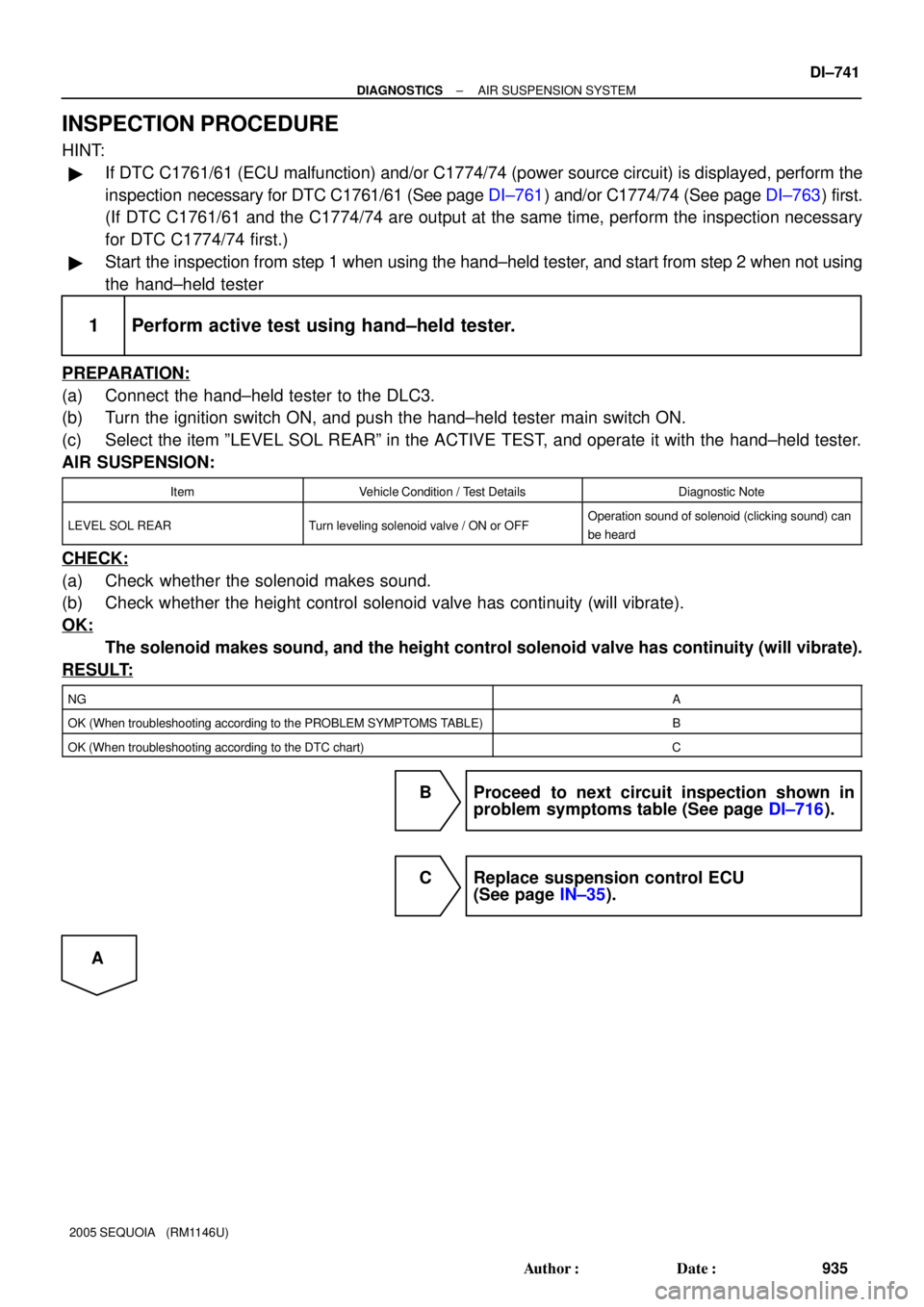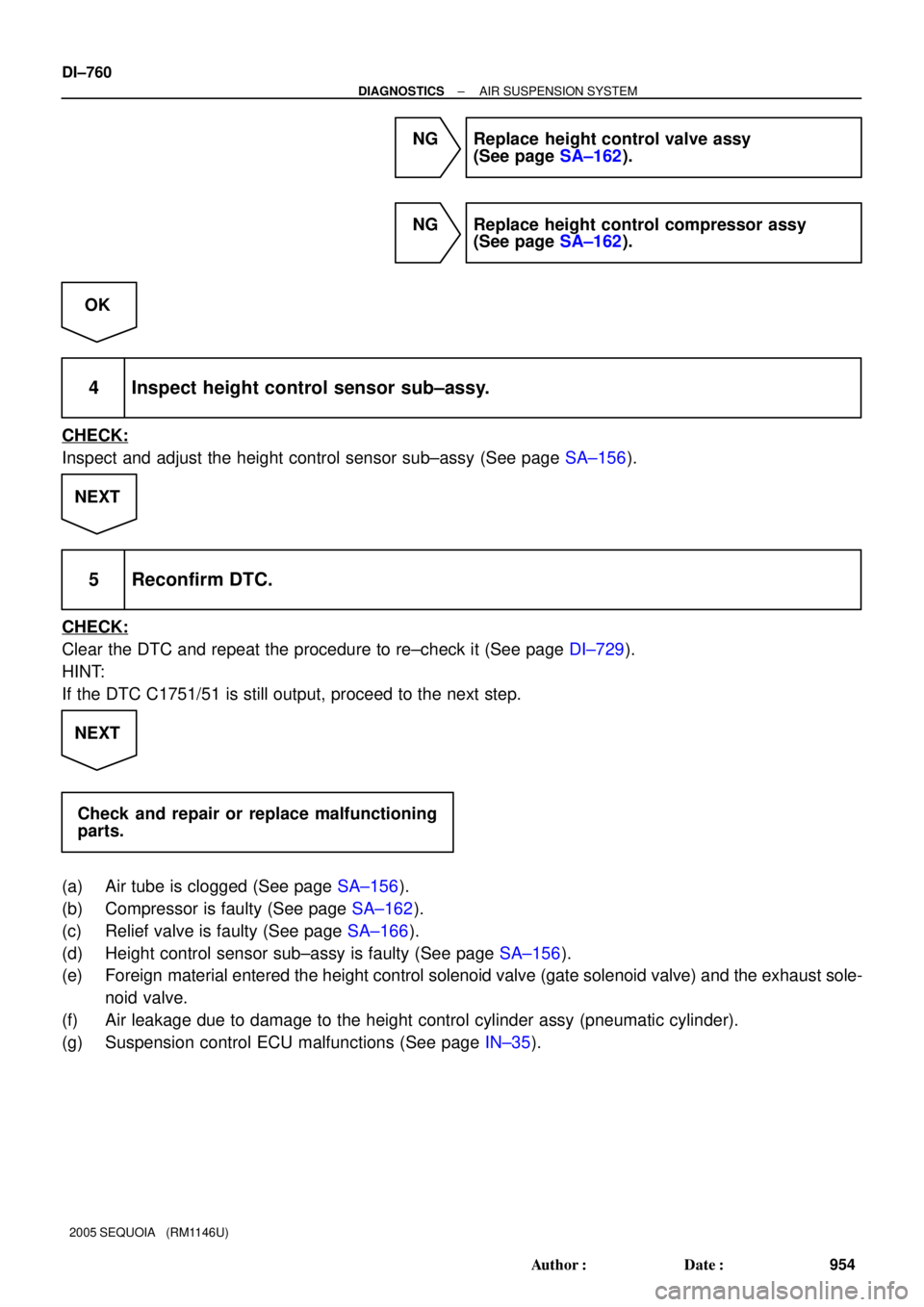Page 940 of 4323
F19437
Connector Front View:
32 1
DI±738
± DIAGNOSTICSAIR SUSPENSION SYSTEM
932 Author�: Date�:
2005 SEQUOIA (RM1146U)
2 Inspect gate solenoid valve (height control valve).
PREPARATION:
Disconnect the valve connector.
CHECK:
Measure the resistance between terminals.
OK:
Solenoid valveTester connectionResistance
Gate solenoid valve1 ± 217.5 to 21.5 W
CHECK:
Check the operating sound of the valves when battery voltage
is applied to the terminals as shown below.
Solenoid valveBattery positiveBattery negative
Gate solenoid valve12
OK:
Operating sound (clicking) can be heard.
HINT:
When a malfunction is found in the gate solenoid valve, replace
the height control valve.
NG Replace height control valve
(See page SA±166).
OK
Page 942 of 4323

F19454
Suspension Control ECU H16
Leveling Solenoid Valve
(Height Control Valve)
LG±R4
BM1SLRR 313
IN13
S25
BI W±B 2LG±R
LG±R DI±740
± DIAGNOSTICSAIR SUSPENSION SYSTEM
934 Author�: Date�:
2005 SEQUOIA (RM1146U)
DTC C1734/34 Leveling Solenoid Valve Circuit
CIRCUIT DESCRIPTION
The suspension control ECU opens the leveling solenoid valve (height control valve) to lead the compressed
air to the height control cylinder (pneumatic cylinder) and to raise the vehicle height.
The height control valve consists of a leveling solenoid valve and a gate solenoid valve.
The leveling solenoid valve opens and closes the passage between the compressor and the height control
cylinder (pneumatic cylinder).
DTC No.DTC Detecting ConditionTrouble Area
C1734/34
Either of the following conditions is detected:
1. With the height control valve inactivated, an open signal of
the height control valve is detected for 1 sec. or more.
2. With the height control valve activated, a short signal of the
valve is detected 8 times successively.
�Leveling solenoid valve (Height control valve)
�Leveling solenoid valve (Height control valve) circuit
�Suspension control ECU
HINT:
�Once the ECU stores DTC C1734/34 in the memory, the vehicle height control is suspended until a
normal signal is input to the ECU from the height control solenoid valves. However, control is resumed
if the ignition switch is turned OFF, then ON again.
�Malfunction in the leveling solenoid valve:
The height control operation is suspended, and the height control indicator lamp does not change by
operating the height control switch.
WIRING DIAGRAM
DIDDR±01
Page 943 of 4323

± DIAGNOSTICSAIR SUSPENSION SYSTEM
DI±741
935 Author�: Date�:
2005 SEQUOIA (RM1146U)
INSPECTION PROCEDURE
HINT:
�If DTC C1761/61 (ECU malfunction) and/or C1774/74 (power source circuit) is displayed, perform the
inspection necessary for DTC C1761/61 (See page DI±761) and/or C1774/74 (See page DI±763) first.
(If DTC C1761/61 and the C1774/74 are output at the same time, perform the inspection necessary
for DTC C1774/74 first.)
�Start the inspection from step 1 when using the hand±held tester, and start from step 2 when not using
the hand±held tester
1 Perform active test using hand±held tester.
PREPARATION:
(a) Connect the hand±held tester to the DLC3.
(b) Turn the ignition switch ON, and push the hand±held tester main switch ON.
(c) Select the item ºLEVEL SOL REARº in the ACTIVE TEST, and operate it with the hand±held tester.
AIR SUSPENSION:
ItemVehicle Condition / Test DetailsDiagnostic Note
LEVEL SOL REARTurn leveling solenoid valve / ON or OFFOperation sound of solenoid (clicking sound) can
be heard
CHECK:
(a) Check whether the solenoid makes sound.
(b) Check whether the height control solenoid valve has continuity (will vibrate).
OK:
The solenoid makes sound, and the height control solenoid valve has continuity (will vibrate).
RESULT:
NGA
OK (When troubleshooting according to the PROBLEM SYMPTOMS TABLE)B
OK (When troubleshooting according to the DTC chart)C
B Proceed to next circuit inspection shown in
problem symptoms table (See page DI±716).
C Replace suspension control ECU
(See page IN±35).
A
Page 944 of 4323
F19437
Connector Front View:
32 1
DI±742
± DIAGNOSTICSAIR SUSPENSION SYSTEM
936 Author�: Date�:
2005 SEQUOIA (RM1146U)
2 Inspect leveling solenoid valve (height control valve).
PREPARATION:
Disconnect the valve connector.
CHECK:
Measure the resistance between terminals.
OK:
Solenoid valveTester connectionResistance
Leveling solenoid valve2 ± 310 to 14 W
CHECK:
Check the operating sound of the valves when battery voltage
is applied to the terminals as shown below.
Solenoid valveBattery positiveBattery negative
Leveling solenoid valve32
OK:
Operating sound (clicking) can be heard.
HINT:
When a malfunction is found in the the leveling solenoid valve,
replace the height control valve.
NG Replace height control valve
(See page SA±166).
OK
Page 946 of 4323

F19455
Suspension Control ECU Exhaust Solenoid Valve
(Height Control Compressor)
L±R5
BM2SLEX 14
IN11
S25
BI W±B 2 H14
H14L±R L±R DI±744
± DIAGNOSTICSAIR SUSPENSION SYSTEM
938 Author�: Date�:
2005 SEQUOIA (RM1146U)
DTC C1735/35 Exhaust Solenoid Valve Circuit
CIRCUIT DESCRIPTION
The suspension control ECU operates the exhaust solenoid valve (height control compressor), releases the
air from the height control cylinder assy (pneumatic cylinder), and lowers vehicle height.
When the vehicle height is lowered, the suspension control ECU opens the height control valve and then
operates the exhaust solenoid valve to release the compressed air to the outside.
The exhaust solenoid valve is on the compressor unit and has only one valve.
DTC No.DTC Detecting ConditionTrouble Area
C1735/35
Either of the following conditions is detected:
1. With the height control valve inactivated, an open signal of
the height control valve is detected for 1 sec. or more.
2. With the height control valve activated, a short signal of the
valve is detected 8 times successively.
�Exhaust solenoid valve (Height control compressor)
�Exhaust solenoid valve (Height control compressor) circuit
�Suspension control ECU
HINT:
�Once the ECU stores DTC C1735/35 in the memory, the vehicle height control is suspended until a
normal signal is input to the ECU from the exhaust solenoid valve. However, control is resumed if the
ignition switch is turned OFF, then ON again.
�Malfunction in the exhaust solenoid valve:
The height control indicator lamp ºNº comes on or blinks, and ºHIº and ºLOº do not come on by operating
the height control switch ºUPº or ºDOWNº.
WIRING DIAGRAM
DIDDS±01
Page 947 of 4323

F19457
Connector Front View:
± DIAGNOSTICSAIR SUSPENSION SYSTEM
DI±745
939 Author�: Date�:
2005 SEQUOIA (RM1146U)
INSPECTION PROCEDURE
HINT:
�If DTC C1761/61 (ECU malfunction) and/or C1774/74 (power source circuit) is displayed, perform the
inspection necessary for DTC C1761/61 (See page DI±761) and/or C1774/74 (See page DI±763) first.
(If DTC C1761/61 and the C1774/74 are output at the same time, perform the inspection necessary
for DTC C1774/74 first.)
1 Inspect exhaust solenoid valve (height control compressor).
PREPARATION:
Disconnect the valve connector.
CHECK:
Measure the resistance between terminals.
OK:
Solenoid valveTester connectionResistance
Exhaust solenoid valve1 ± 210 to 14 W
CHECK:
Check the operating sound of the valves when battery voltage
is applied to the terminals as shown below.
Solenoid valveBattery positiveBattery negative
Exhaust solenoid valve12
OK:
Operating sound (clicking) can be heard.
HINT:
When a malfunction is found in the exhaust solenoid valve, re-
place the height control compressor.
NG Replace height control compressor assy
(See page SA±162).
OK
Page 961 of 4323

F19437
Height Control Valve
Connector Front View:
32 1
F19457
Height Control Compressor
Connector Front View:
± DIAGNOSTICSAIR SUSPENSION SYSTEM
DI±759
953 Author�: Date�:
2005 SEQUOIA (RM1146U)
3 Inspect height control valve (Gate solenoid valve, Leveling solenoid valve) or
height control compressor (Exhaust solenoid valve).
When using hand±held tester:
PREPARATION:
(a) Connect the hand±held tester to the DLC3.
(b) Turn the ignition switch ON, and push the hand±held tester main switch ON.
(c) Select the item ºLEVEL SOL REARº, ºGATE SOL REARº in the ACTIVE TEST, and operate it with the
hand±held tester.
AIR SUSPENSION:
ItemVehicle Condition / Test DetailsDiagnostic Note
LEVEL SOL REARTurn leveling solenoid valve / ON or OFFOperation sound of solenoid (clicking sound) can
be heard
GATE SOL REARTurn gate solenoid valve / ON or OFFOperation sound of solenoid (clicking sound) can
be heard
HINT:
The exhaust solenoid valve cannot be tested in ACTIVE TEST.
CHECK:
(a) Check whether the solenoid makes a sound.
(b) Check whether the height control solenoid valve has continuity (will vibrate).
OK:
The solenoid makes a sound, and the height control solenoid valve has continuity. (It will vi-
brate.)
When not using hand±held tester:
PREPARATION:
Disconnect the valve connector.
CHECK:
Check the operating sound of the valves when battery positive
voltage is applied to the terminals as shown below.
Solenoid valveBattery positiveBattery negative
Height control valve
(Gate solenoid valve)12
Height control valve
(Leveling solenoid valve)32
Height control compressor
(Exhaust solenoid valve)12
OK:
It make an operating sound (click).
HINT:
�When a malfunction is found in the gate solenoid valve,
replace the leveling valve and the height control valve.
�When a malfunction is found in the exhaust solenoid
valve, replace the height control compressor assy.
Page 962 of 4323

DI±760
± DIAGNOSTICSAIR SUSPENSION SYSTEM
954 Author�: Date�:
2005 SEQUOIA (RM1146U)
NG Replace height control valve assy
(See page SA±162).
NG Replace height control compressor assy
(See page SA±162).
OK
4 Inspect height control sensor sub±assy.
CHECK:
Inspect and adjust the height control sensor sub±assy (See page SA±156).
NEXT
5 Reconfirm DTC.
CHECK:
Clear the DTC and repeat the procedure to re±check it (See page DI±729).
HINT:
If the DTC C1751/51 is still output, proceed to the next step.
NEXT
Check and repair or replace malfunctioning
parts.
(a) Air tube is clogged (See page SA±156).
(b) Compressor is faulty (See page SA±162).
(c) Relief valve is faulty (See page SA±166).
(d) Height control sensor sub±assy is faulty (See page SA±156).
(e) Foreign material entered the height control solenoid valve (gate solenoid valve) and the exhaust sole-
noid valve.
(f) Air leakage due to damage to the height control cylinder assy (pneumatic cylinder).
(g) Suspension control ECU malfunctions (See page IN±35).